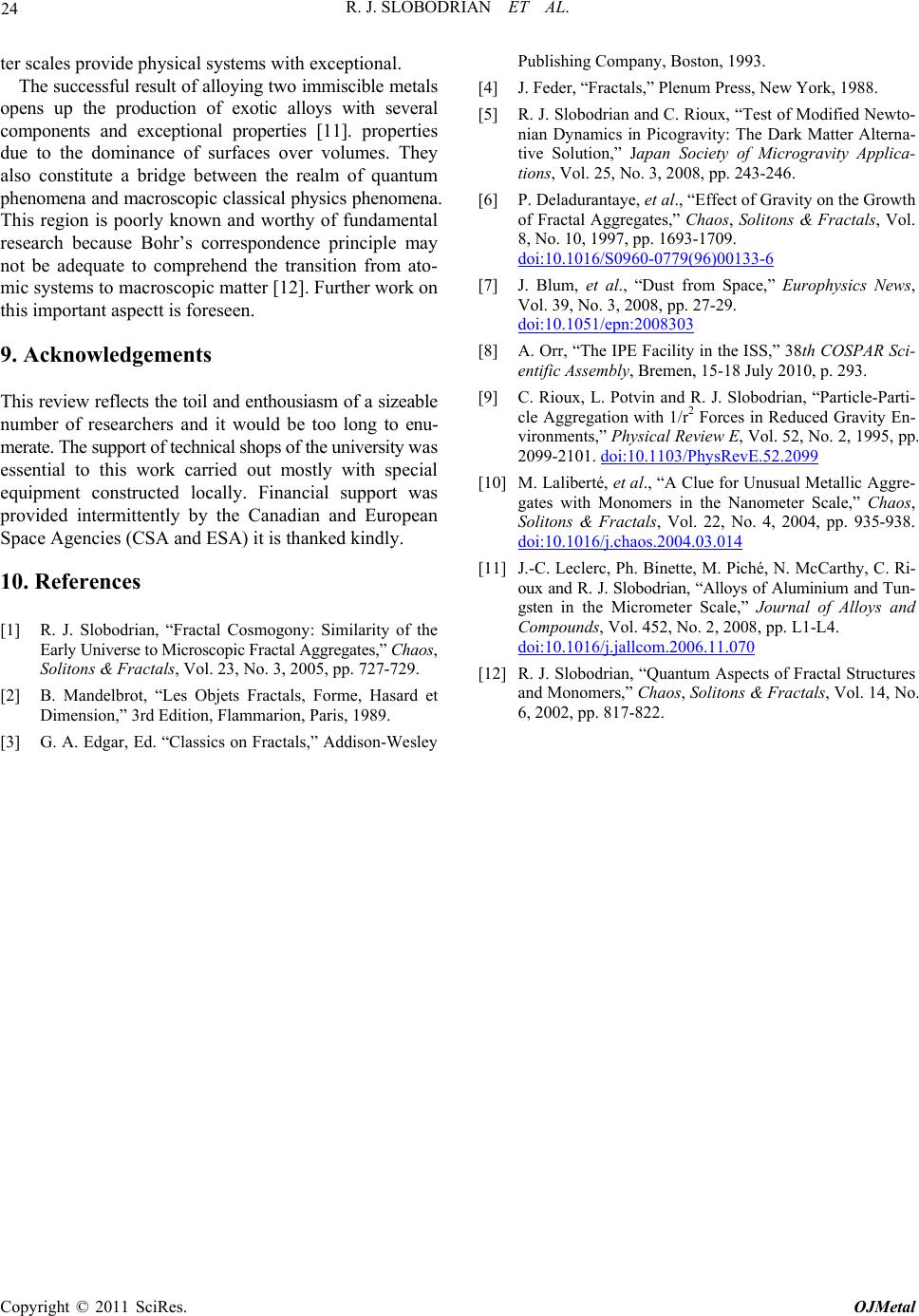
R. J. SLOBODRIAN ET AL.
Copyright © 2011 SciRes. OJMetal
24
ter scales provide physical systems with exceptional.
The successful result of alloying two immiscible metals
opens up the production of exotic alloys with several
components and exceptional properties [11]. properties
due to the dominance of surfaces over volumes. They
also constitute a bridge between the realm of quantum
phenomena and macroscopic classical physics phenomena.
This region is poorly known and worthy of fundamental
research because Bohr’s correspondence principle may
not be adequate to comprehend the transition from ato-
mic systems to macroscopic matter [12]. Further work on
this important aspectt is foreseen.
9. Acknowledgements
This review reflects the toil and enthousiasm of a sizeable
number of researchers and it would be too long to enu-
merate. The support of technical shops of the university was
essential to this work carried out mostly with special
equipment constructed locally. Financial support was
provided intermittently by the Canadian and European
Space Agencies (CSA and ESA) it is thanked kindly.
10. References
[1] R. J. Slobodrian, “Fractal Cosmogony: Similarity of the
Early Universe to Microscopic Fractal Aggregates,” Chaos,
Solitons & Fractals, Vol. 23, No. 3, 2005, pp. 727-729.
[2] B. Mandelbrot, “Les Objets Fractals, Forme, Hasard et
Dimension,” 3rd Edition, Flammarion, Paris, 1989.
[3] G. A. Edgar, Ed. “Classics on Fractals, ” Addison-Wesley
Publishing Company, Boston, 1993.
[4] J. Feder, “Fractals,” Plenum Press, New York, 1988.
[5] R. J. Slobodrian and C. Rioux, “Test of Modified Newto-
nian Dynamics in Picogravity: The Dark Matter Alterna-
tive Solution,” Japan Society of Microgravity Applica-
tions, Vol. 25, No. 3, 2008, pp. 243-246.
[6] P. Deladurantaye, et al., “Effect of Gravity on the Growth
of Fractal Aggregates,” Chaos, Solitons & Fractals, Vol.
8, No. 10, 1997, pp. 1693-1709.
doi:10.1016/S0960-0779(96)00133-6
[7] J. Blum, et al., “Dust from Space,” Europhysics News,
Vol. 39, No. 3, 2008, pp. 27-29.
doi:10.1051/epn:2008303
[8] A. Orr, “The IPE Facility in the ISS,” 38th COSPAR Sci-
entific Assembly, Bremen, 15-18 July 2010, p. 293.
[9] C. Rioux, L. Potvin and R. J. Slobodrian, “Particle-Parti-
cle Aggregation with 1/r2 Forces in Reduced Gravity En-
vironments,” Physical Review E, Vol. 52, No. 2, 1995, pp.
2099-2101. doi:10.1103/PhysRevE.52.2099
[10] M. Laliberté, et al., “A Clue for Unusual Metallic Aggre-
gates with Monomers in the Nanometer Scale,” Chaos,
Solitons & Fractals, Vol. 22, No. 4, 2004, pp. 935-938.
doi:10.1016/j.chaos.2004.03.014
[11] J.-C. Leclerc, Ph. Binette, M. Piché, N. McCarthy, C. Ri-
oux and R. J. Slobodrian, “Alloy s of Aluminium and Tun-
gsten in the Micrometer Scale,” Journal of Alloys and
Compounds, Vol. 452, No. 2, 2008, pp. L1-L4.
doi:10.1016/j.jallcom.2006.11.070
[12] R. J. Slobodrian, “Quantum Aspects of Fractal Structures
and Monomers,” Chaos, Solitons & Fractals, Vol. 14, No.
6, 2002, pp. 817-822.